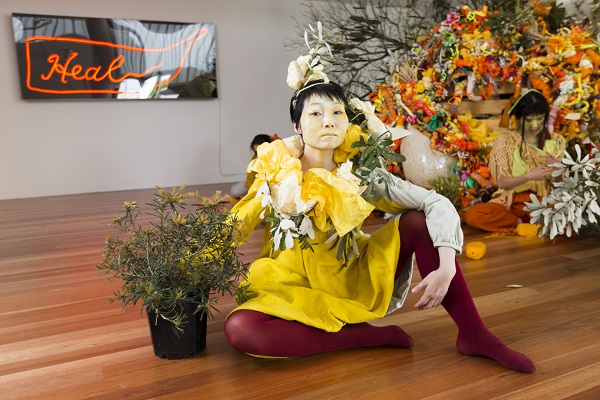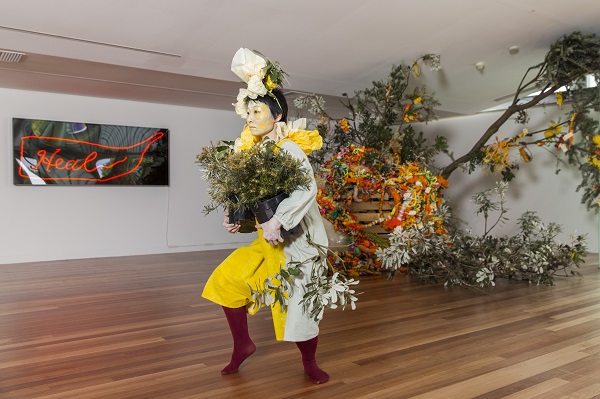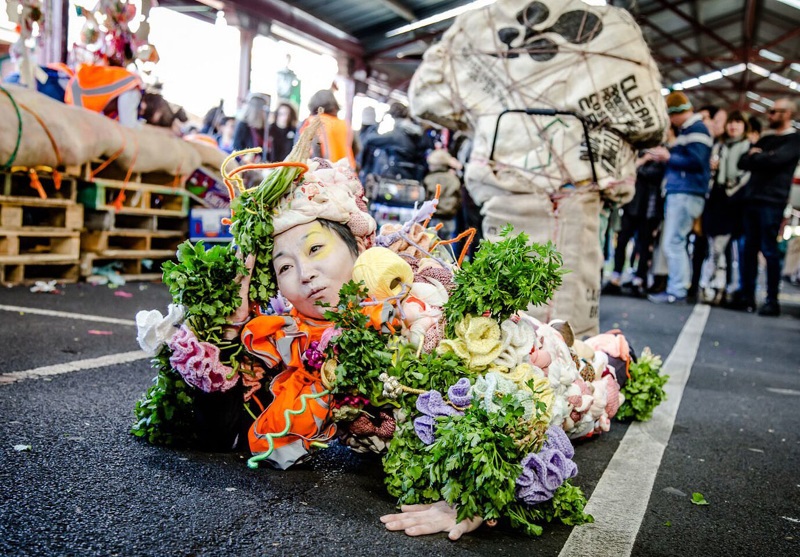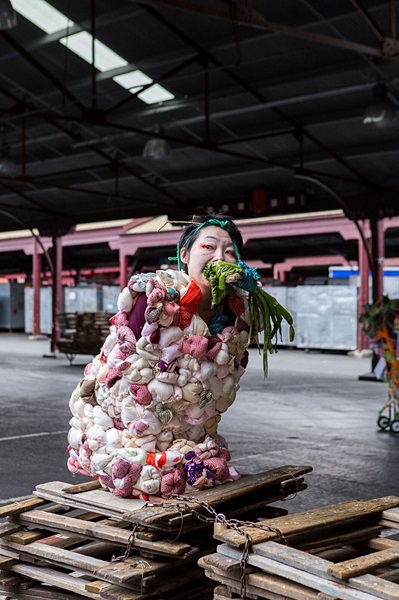
LOCAL ARTIST Hiromi Tango is one of six artists from across the state vying for the prestigious 2017 NSW Visual Artists Fellowship.
The Fellowship supports the professional development of a later-career NSW artist and includes $30,000, an acquisitive Artbank commission up to $20,000 and a residency at either the Murray Arts Museum Albury or the Tweed Regional Gallery & Margaret Olley Arts Centre.
Hiromi is an internationally exhibited sculptural and performative artist who explores how the arts can engage with aging and emotional recovery. She creates large scale fabric sculptures using a variety of materials. Her installations involve performance where she often becomes part of the artwork.
She was born in Japan and received her Bachelor of Arts (Humanity and Culture of Arts) from Japan Women’s University in Tokyo in 1998.
Hiromi has won several awards including the 2015 Gold Coast Art Prize and the Qantas Encouragement of Contemporary Art Award (2011) and has been the recipient of several government grants.
Her solo exhibitions include Art Magic Climbing Tree, Cairns Regional Gallery, Art Magic Remnant, Lismore Regional Gallery and Fluorescence, Sullivan+Strumpf, Sydney. Her work has been featured in group exhibitions at the Ian Potter Museum, Melbourne, Art Brussels, Art Basel Hong Kong and la Maison Folie, Mons, Belgium.
Her husband Craig Walsh is also an artist and she has exhibited several collaborative works with him.
Hiromi’s large-scale ‘performative installations’ are premised on the notion of interactivity, forging individual, social and cultural connections. Her installations are often collaborative, performative and site-specific. The immersive installations comprise vibrant sculptural accumulations of donated objects, materials and stories.
Hiromi has just returned from Contour 556, Canberra’s New Public Art Festival. Her large scale installation ‘Banksia Magic’ explored the healing aspects of native plants used by the Ngunnawal people for medicinal purposes.

With the help of community members creating their own Banksia Magic flowers, Banksia Magic will grow and flourish. The work will culminate in a healing performance, where the colour tissue and balloon flowers will blossom, releasing the difficult memories and emotions and transforming them into new energy.
She recently created an installation at the Queen Victoria Market as part of Melbourne Festival, 2016. Her installation ‘Wrapped’, inspired by the landscape of the Queen Victoria Market, where the space is packed up each day and stalls are wrapped in hessian and rope.
To Hiromi this space is reminiscent of the sleeping brain, the subconscious, and genes which carry the memories of the market.

The recipient of the 2017 NSW Visual Artists Fellowship will be announced at the public launch of the shortlist exhibition at Artbank Sydney on December 1, 2016.
The Weekly spoke with Hiromi during a Q&A to find more about her inspiration and connection to the Tweed.
Q1. What aspects of the Tweed inspire your art?
“The unique mixture of natural and urban environment of the Tweed has always been inspirational and I found Tweed “textured” like a hand woven fabric, such as mangroves, the river, the beach, and astonishing natural environment including very healthy birds habitats.
It is a very diverse environment and I find it fascinating.
I like the way we use our natural environment everyday here – fishing, swimming, etc. – it is a very healthy and active lifestyle. I always feel revitalised and at home when I come back to Tweed Heads. I enjoy the benefit of living in a healthy, active and friendly local community. There are lots of young families, new people moving in the area, and established community living here for over 30 years, including seniors, and a diverse and healthy life cycle including the transit nature of place.”
Q2. What would winning the Fellowship Award mean to you?
“It is a great honour to be deemed worthy of a fellowship among my peers across NSW. A fellowship would provide an opportunity to focus on my current research: how arts engagement enhance the social connectedness, mental health and wellbeing, and which regions of the brain is activated, and how healthy brain circuit would be developed when you are engaging with arts and movement.
How can we create the nurturing environment – Healthy Brain Food for our brain circuit. The opportunity to collaborate with neuroscientists, and health professionals, and the local organisations and community members would be very exciting and rewarding.”

Q3. Why do you believe it’s important to support regional art galleries?
“Regional Galleries play a very important role in fostering local culture, as well as providing opportunities for regionally-based artists to share their work in a professional setting. I have really enjoyed working with Lismore Regional Art Gallery in recent years, and am excited by the potential to do more projects. I have also wanted to work with Tweed Regional Gallery for a long time, and I am hoping that I will be able to work with them and the local community members in the near future.
Regional art galleries are very important as they are like a heart in the community, pumping blood and providing nourishment for our brains.
When we live with art, we are always free. There are unlimited potentials. You will never get bored.
I grew up in the regional Japan, and without exaggeration, art changed my life.
I sincerely believe in the indirect but powerful effect of art, and how art can enhance our mental health, well-being and social connectedness. Regional Art Galleries plays many roles beyond the Art Gallery, such as a community centre, where people meet and socialise.”
Q4. Could you please describe your art and the inspirations behind it?
“I am fascinated by neurosciences, particularly with regard to how arts engagement may have an impact on aspects of healthy brain development, trauma recovery, and preserving memory in aging brains. Many of my projects have drawn inspiration from nature, using ideas such as the ability of the lizard to drop its tail and regrow it as a metaphor for brain processes, or exploring the healing aspects of native plant life, and creating artwork which involves public engagement and collaboration with local community groups. My work is a mix of sculptural installation, performance and creating multi-sensory experiences through sound, light and aromatherapy – each work has its own character that develops quite organically in response to the environment and a particular idea that I am interested in.”